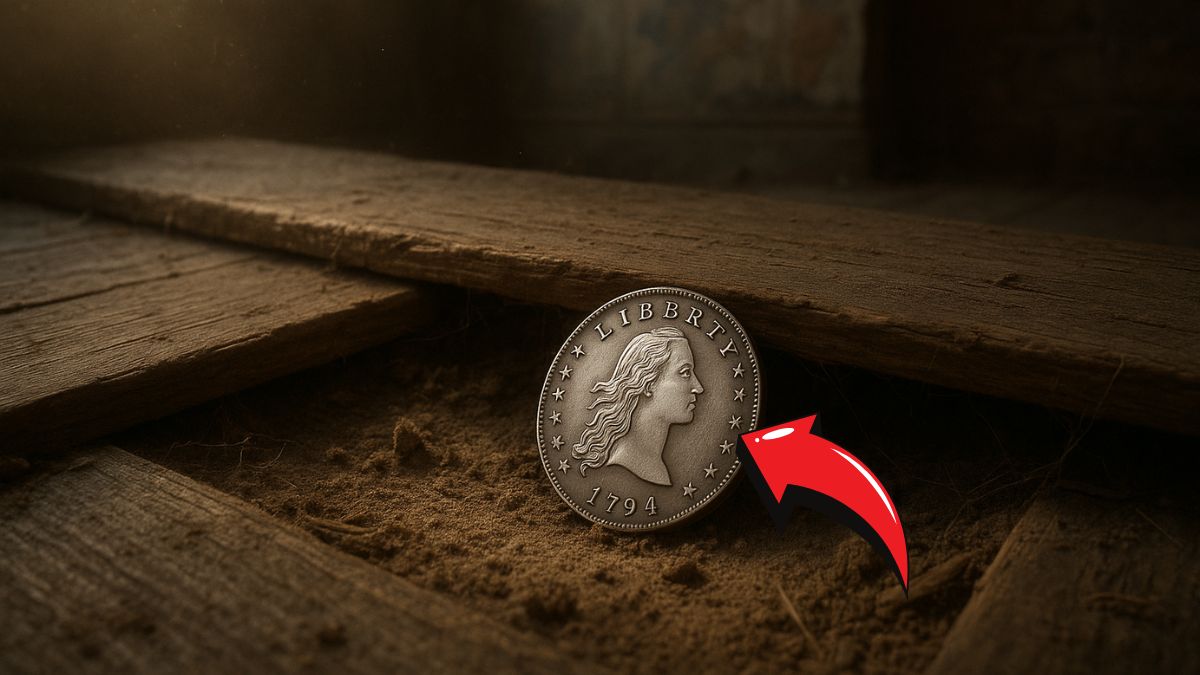In a remarkable turn of events, a homeowner’s routine renovation led to the discovery of a coin so rare that experts have dubbed it a “one-in-a-billion” find.
Hidden beneath the floorboards of a 19th-century house, this coin has captivated historians and numismatists alike, shedding light on a significant piece of American history.
The Discovery: A Hidden Treasure Beneath the Floor
While undertaking renovations in his historic home, an anonymous individual stumbled upon a dusty, discolored coin wedged between two joists under a loose wooden floorboard.
Initially overlooked, the coin was later identified as a 1794 Flowing Hair Silver Dollar—a coin of immense historical and monetary value.
The 1794 Flowing Hair Silver Dollar: A Numismatic Marvel
The 1794 Flowing Hair Silver Dollar holds a distinguished place in American numismatics. As one of the first silver dollars minted by the United States, only about 1,750 were ever produced, and far fewer exist today.
The coin features a portrait of Lady Liberty with flowing hair on the obverse and an eagle surrounded by a wreath on the reverse. Its rarity and historical significance make it a coveted piece among collectors.
Expert Analysis and Valuation
Upon discovery, the coin underwent rigorous evaluation by numismatic experts. Dr. Emily Larson, a renowned coin historian, noted the coin’s exceptional preservation, stating, “Coins this old typically show extreme wear or corrosion.
But this one? It appears to have been shielded from air and moisture. It’s incredibly well-preserved considering where it was found.”
Jeff Carson, a senior appraiser with the National Coin Assessment Board, emphasized the coin’s rarity: “The odds of finding a 1794 Flowing Hair Dollar under a floorboard are nearly astronomical. We’re talking one in a billion.”
Preliminary grading places the coin at AU-58 (Almost Uncirculated), a rating that significantly enhances its value. Auction houses estimate that the coin could fetch over $10 million, depending on bidding dynamics.
Historical Context: How Did the Coin End Up There?
The house, built in the early 1800s, may have belonged to a wealthy merchant or collector.
During that era, it was common for individuals to hide valuables within walls or under floorboards to protect them from theft or fire.
Over time, such hidden treasures could be forgotten, only to be rediscovered decades or centuries later.
Comparative Discoveries: Other Notable Coin Finds
While the discovery of the 1794 Flowing Hair Silver Dollar is extraordinary, it’s not the only instance of valuable coins being found in unexpected places.
For example, in 2019, a couple in Ellerby, North Yorkshire, uncovered a hoard of 264 gold coins dating from 1610 to 1727 beneath their kitchen floor during renovations.
This collection, linked to the Fernley-Maisters, a wealthy mercantile family, was sold at auction for £754,000.
Information Table: Key Details of the Discovery
| Aspect | Details |
|---|---|
| Coin Discovered | 1794 Flowing Hair Silver Dollar |
| Location Found | Beneath floorboards in a 19th-century house |
| Condition | AU-58 (Almost Uncirculated) |
| Estimated Value | Over $10 million |
| Historical Significance | One of the first silver dollars minted by the U.S.; extremely rare find |
The accidental discovery of the 1794 Flowing Hair Silver Dollar beneath floorboards serves as a compelling reminder of the hidden treasures that may lie unnoticed in our surroundings.
This one-in-a-billion find not only offers a tangible connection to the early days of American history but also underscores the enduring allure of numismatics.
As the coin prepares to make its way to auction, it stands as a testament to the surprises that history can still hold.
FAQs
What makes the 1794 Flowing Hair Silver Dollar so valuable?
Its value stems from its historical significance as one of the first silver dollars minted by the United States, its rarity due to limited mintage, and its exceptional condition.
How was the coin preserved so well under the floorboards?
The coin’s location likely shielded it from air and moisture, preventing corrosion and wear over time.
Are there legal implications for finding such a valuable coin?
Laws vary by jurisdiction, but typically, if the coin is found on private property and not classified as treasure trove, the finder may have legal ownership.

